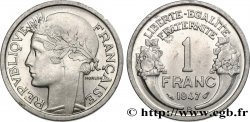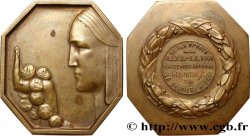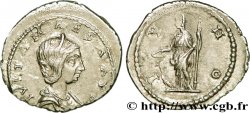v30_1291 - Essai 50 francs Guiraud 1950 Paris F.425/1
MONNAIES 30 (2007)
Prezzo di inizio : 200.00 €
Valutazione : 600.00 €
Prezzo realizzato : 207.00 €
Numero di offerte : 2
Offerta maxima : 207.00 €
Prezzo di inizio : 200.00 €
Valutazione : 600.00 €
Prezzo realizzato : 207.00 €
Numero di offerte : 2
Offerta maxima : 207.00 €
Tipo : Essai 50 francs Guiraud
Data: 1950
Nome della officina / città: Paris
Quantità coniata : 1700
Metallo : bronzo-alluminio
Diametro : 27,03 mm
Asse di coniazione : 6 h.
Peso : 8,11 g.
Orlo : lisse
Grado di rarità : R1
Commenti sullo stato di conservazione:
Superbe exemplaire avec de petites marques de manipulation et quelques petits chocs sur la joue. Quelques légères traces de circulation. Conserve une grande partie de son brillant d’origine
N° nelle opere di riferimento :
Diritto
Titolatura diritto : REPUBLIQUE FRANCAISE.
Descrittivo diritto : Tête de Marianne aux cheveux longs à gauche, couronnée d'une branche d'olivier portant fruit, ornée d'une cocarde tricolore (centre guilloché horizontalement, cercle ondulé, cercle guilloché verticalement) ; signé G. GUIRAUD derrière, le long du listel.
Rovescio
Titolatura rovescio : LIBERTE EGALITE FRATERNITE / ESSAI.
Descrittivo rovescio : 1950 / 50 / FRANCS / (millésime encadré des différents) ; coq debout à droite au-dessus d'une branche de laurier vers la gauche.
Commento
On doit noter sur cet exemplaire que le coin utilisé était une ruine, choqué de toutes les manières imaginables, qui a transposé ses propres défauts sur la pièce et que la surface du métal présente des striures difficilement compréhensibles. C’est pourtant le nouvel exemplaire de la Collection Idéale, ce qui laisse à penser que toute la fabrication, coins et métal obligent, fut désastreuse.
It should be noted on this example that the die used was a ruin, damaged in every imaginable way, which has transferred its own defects onto the coin and that the surface of the metal presents striations that are difficult to understand. However, this is the new example in the Ideal Collection, which suggests that the entire manufacturing process, including the dies and the metal, was disastrous.
It should be noted on this example that the die used was a ruin, damaged in every imaginable way, which has transferred its own defects onto the coin and that the surface of the metal presents striations that are difficult to understand. However, this is the new example in the Ideal Collection, which suggests that the entire manufacturing process, including the dies and the metal, was disastrous.








 Segnalare un errore
Segnalare un errore Stampate la pagina
Stampate la pagina Condividi mia selezione
Condividi mia selezione Fai una domanda
Fai una domanda Consegnare / vendere
Consegnare / vendere
 Descrittivo
Descrittivo











